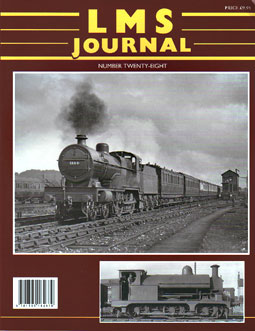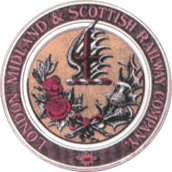LMS JOURNAL
Issues
LMSJ Issue 28
ISBN 978 1 905184 67 5

|
Contents
|
EDITORIAL
We complete this year's programme of LMS Journals with a strong Scottish flavour. When I asked for further information about the use of indicators carried by locomotives running on LMS lines in Scotland, I was unsure what response I would receive, but I was delighted with the comment that came from readers and in particular the offer by Stuart Rankin to write an article about the subject, which appears in this issue. By coincidence, the LMS Signals series by long standing contributor Graham Warburton describes the installation of the colour light signalling at St. Enoch in Glasgow.
Regardless of size, all articles are important to me. I see them as 'building blocks' that make up the growing structure of LMS Journal, but from time to time we include articles that I think are particularly important and make a point that needs to be underlined. Although in previous editorials I have written words to the effect that this is not a modellers' magazine, I am deeply conscious that many modellers use the information contained to help them make more accurate models. Accuracy comes in many forms, and the point I wish to make in this editorial is the age of stock. The subject was considered in LMS Journal No. 5 when I examined the LMS carriage and wagon renewals, comparing the position at 1st January with the position as at the end of 1935. The trade largely drives the model railway hobby and they tend to concentrate upon the most modern or latest items built, probably because they believe they will sell more. I should add that during the hundred or so years the hobby has been in existence, this principle has been a constant factor. The reality for model makers is that if you rely upon the trade, then the chances are that the average age of your rolling stock will be too modern. Let me illustrate this point.
During the early 1950s, it was probably 1951/2, we used to have a trip working at Saltley that took us to the west end sidings at Washwood Heath, Birmingham. During the hour or so between trips we would screw down the engine handbrake, fill the boiler, close the damper and open the firedoors, then my driver used to go to 'the cabin', where newspapers could be read, dominoes played or horse racing discussed. To me, if it was a sunny day, it was far more interesting to walk along the sidings looking at the wagon builders and register plates. At this time, the new 16 ton steel coal wagons were coming into service in considerable numbers, but during my examination of the register plates, dates between 1900 and 1912 were not uncommon, while from time to time I would find one with an 1890s date. I have never forgotten the excitement when I found a pre 1900 plate. Sadly, I made no records of what I saw, but I think this experience makes the point about the average age of freight rolling stock.
Many years ago the LNWR Society began a project designed to record the history of the company's goods rolling stock and Volume 1 has been published. Earlier this year, I asked if, in advance of the publication of Volume 2, the authors would write an article describing what happened to the company's stock during the LMS period and continue the story into the era of British Railways. I am pleased to say they have and it is included in this issue. What I can say is that if readers are interested in LMS freight stock and do not have Volume 1, then there is a hole to fill in your library!
Bob Essery
Site contents Copyright © Cygnet Magazines Limited, 2014-2025.




